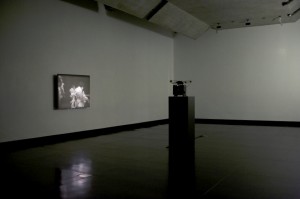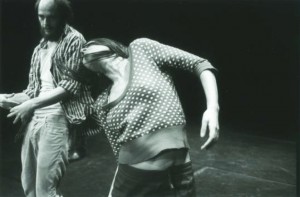Tarantism by Joachim Koester is a film prefaced on letting go. Bodies writhe and lash around the screen in attempts to release themselves. Watching these photogenic bodies move around, we are hypnotised by the rhythmic metronomic projector throwing up the images. Hypnotic trances, when working well, open up sideline spaces, enabling the focal point to shift from the centre to the edge.
I Participate
Wisps of hair flick through space, hitting the edges of the frame, cutting, yet always seductive. In these moments, intensity is not generated from within the torso, but instead expands beyond boundaries towards unknown trajectories: the rapture of letting go when you can’t see the function of the body, its extension into an abstract ideal, the whiplash of hair from a spasmodic head reaching beyond its line. An image hits off the body, off its form, and transmutes, to scratch the edges of a screen.
II Watch
A body is writhing on the floor while the other performers stand around and watch in a circle-like shape, a roda. Robert Hinton, writing in ‘Black dance in American history’, for the 1988 American Dance Festival Program booklet, distinguishes between dual audiences where, a) the dance can be created for the benefit of the dancers, where the experience for the audience is secondary, and b) the dance can be created for the pleasure of the audience, where the experience of the performer is secondary.
Here, in its rigidness, the polarity between the writhing dancer and viewing/inactive performers situates the space and the incongruity of this moment in Tarantism so that it feels like the edge of the peak. As the performers bandy together they cleave energy off one another to gather momentum for their tarantism. In the circle the inactive performers watch the active dancer’s seizure-like rapture as a precedent to perform, to dance. In this sideline, the investment, the articulation and the relationships shift. This is not to define the gestures, but to create a lineage and use it as a vessel for focus, to delve further, go deeper, get lost.
III Release
The dancers stop. Puffed out, breathing heavily, showing the exertion of their sustained performance. The panting completes the dance. Without it we can’t expel our own breath or even recognise we’ve been holding it.
Without it we can’t recognise what we’ve gotta do.
Gotta dance.
Joachim Koester: Tarantism, Ian Potter Museum of Art, University of Melbourne, 20 March – 2 June 2013.



